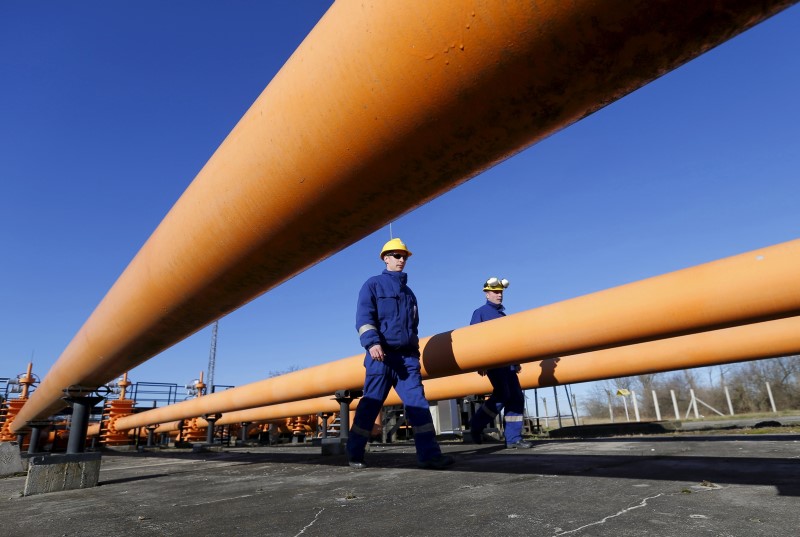* Russian gas exports to Europe hit record
* Europe misses the boat despite growth in LNG exports
* Gas tankers to challenge Gazprom supplies from mid-2017
* Atlantic LNG failures give Algeria's exports a boost
* Graphic: LNG terminals in EU http://tmsnrt.rs/2iawIPA
By Oleg Vukmanovic
MILAN, Jan 9 (Reuters) - Russia looks set to grab more market share in Europe's natural gas sector in the first half of this year after gaining ground in 2016 despite EU efforts to diversify away from Moscow's energy exports and a global glut of liquefied natural gas.
With the United States finally breaking the seal on LNG exports last year, analysts envisaged the ocean-going tankers challenging Russia's land-locked pipelines supplying Europe in a race that would send gas prices ever lower.
But with attacks on Nigerian pipelines that would have sold supplies into Latin America, new consumers and nuclear outages in Asia, major U.S. gas shippers and other exporters took advantage of the shortages to plug those gaps. The United States sent only two shipments to Europe, analysts said.
Industry consultants expect LNG to stay scarce in Europe for at least the next six months, giving Russia's Gazprom GAZP.MM - already supplying a third of Europe's gas needs - free rein to capture more market share.
"They are now in a position to keep raising exports as European gas demand grows, domestic production falls, and Gazprom's cost-competitive sales strategy keeps LNG flowing to other regions," Thierry Bros, senior research fellow at the Oxford Institute of Energy Studies said.
On Saturday, Gazprom said its daily supplies of natural gas to countries outside the former Soviet Union had reached a record high due to cold weather in Europe. in Europe over relying on Russia for gas since pricing spats between Moscow and Kiev disrupted supplies has grown in the wake of Russia's seizure of the Crimea region from Ukraine in March 2014.
While, the EU has succeeded in increasing renewables and the use of reverse-flow pipelines to maximise available supplies, some countries are still 100 percent dependent on Russian gas.
Sharply rising U.S. LNG exports could provide an alternative.
In reality though, Gazprom, and Algeria's state-run gas exporter Sonatrach, enjoyed unfettered expansion, with Gazprom also tweaking long-term deals with European clients, who have become more demanding thanks to the rival sources of fuel.
SUPPLY FAILURES
"The aggregate amount of gas exported to Europe in 2016 - and I can say that for certain - is expected to exceed 179 billion cubic metres. That is a historic high," Gazprom's CEO Alexei Miller said on Dec. 30.
In contrast, Europe got just two U.S. shipments, while top producer Qatar homed in on growth markets including India, Egypt, Pakistan and Jordan - slashing exports to Europe by 16 percent to 17.5 million tonnes, FACTS Global Energy senior analyst Kittithat Promthaveepong said.
The latest estimates suggest Europe's overall imports fell slightly in 2016 despite a 6.2 percent jump in global LNG output to 263.7 million tonnes, independent consultant Andy Flower said.
Attacks on pipelines in Nigeria and dwindling resources in Trinidad, once stalwarts of the LNG export market, took supplies off the open market and gave new U.S. LNG producers an opening to plough shipments into South America, not Europe.
"LNG supply failures in the Atlantic deprived northwest Europe of hoped-for supply, benefiting mainly the continent's two biggest pipeline suppliers - Russia and Algeria," said Ira Joseph, head of global gas and power at Pira Energy.
Algerian exports to Italy rose to 17.1 bcm compared with 7.1 bcm in 2015, according to Pira figures.
"Russian and Algerian pipeline exports benefited greatly from Europe's LNG standstill and they are poised to benefit so long as Atlantic Basin LNG production problems persist and Asian nuclear outages keep shipments flowing towards the Far East," Joseph said.
However, Gazprom will not get a free pass indefinitely, as the situation begins to turn again from the middle of 2017, Pira's Joseph and FACTS' Promthaveepong say.
At that point, new LNG production growth from the United States and Australia should start spilling over into Europe as new markets will struggle to absorb surpluses fast enough.
FACTS expects up to 20 million tonnes of extra supply to be pushed into Europe above and beyond the region's natural demand as production fully ramps up towards the end of the decade.
<^^^^^^^^^^^^^^^^^^^^^^^^^^^^^^^^^^^^^^^^^^^^^^^^^^^^^^^^^^^ LNG terminals in the EU
http://tmsnrt.rs/2iawIPA
^^^^^^^^^^^^^^^^^^^^^^^^^^^^^^^^^^^^^^^^^^^^^^^^^^^^^^^^^^^>
